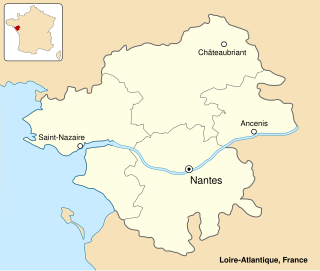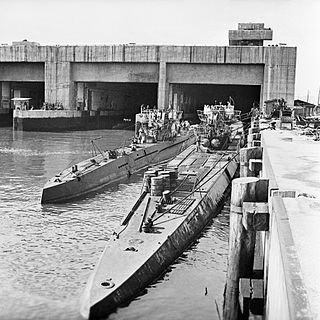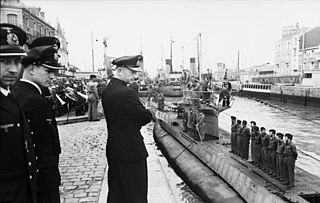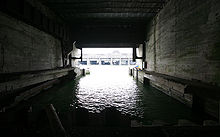
A dry dock is a narrow basin or vessel that can be flooded to allow a load to be floated in, then drained to allow that load to come to rest on a dry platform. Dry docks are used for the construction, maintenance, and repair of ships, boats, and other watercraft.

The St Nazaire Raid or Operation Chariot was a British amphibious attack on the heavily defended Normandie dry dock at St Nazaire in German-occupied France during the Second World War. The operation was undertaken by the Royal Navy (RN) and British Commandos under the auspices of Combined Operations Headquarters on 28 March 1942. St Nazaire was targeted because the loss of its dry dock would force any large German warship in need of repairs, such as Tirpitz, sister ship of Bismarck, to return to home waters by running the gauntlet of the Home Fleet of the Royal Navy and other British forces, via the English Channel or the North Sea.

Saint-Nazaire is a commune in the Loire-Atlantique department in western France, in traditional Brittany.

USS Buchanan (DD-131), named for Franklin Buchanan, was a Wickes-class destroyer in the United States Navy.

HMS Campbeltown was a Town-class destroyer of the Royal Navy during the Second World War. She was originally US destroyer USS Buchanan, and was one of 50 obsolescent U.S. Navy destroyers transferred to the Royal Navy in 1940 as part of the Destroyers for Bases Agreement. Campbeltown became one of the most famous of these ships when she was used in the St Nazaire Raid in 1942.

A submarine pen is a type of submarine base that acts as a bunker to protect submarines from air attack.

Dora I is a former German submarine base and submarine pen or bunker built in Trondheim, Norway. Construction of the bunker was undertaken during the Second World War. Nearby is the uncompleted Dora II. Trondheim was traditionally referred to as Drontheim in German, and the name DORA is the letter "D" in the German phonetic alphabet.

German submarine U-96 was a Type VIIC U-boat of the German Navy (Kriegsmarine) during World War II. It was made famous after the war in Lothar-Günther Buchheim's 1973 bestselling novel Das Boot and the 1981 Oscar-nominated film adaptation of the same name, both based on his experience on the submarine as a war correspondent in 1941.

German submarine U-94 was a Type VIIC U-boat of Nazi Germany's Kriegsmarine during World War II. She was laid down on 9 September 1939 at the F. Krupp Germaniawerft in Kiel as yard number 599, launched on 12 June 1940 and commissioned on 10 August 1940 under Kapitänleutnant Herbert Kuppisch.

German submarine U-74 was a Type VIIB U-boat of Nazi Germany's Kriegsmarine during World War II.

Le Croisic is a commune in the Loire-Atlantique department, western France. It is part of the urban area of Saint-Nazaire.

BETASOM was a submarine base established at Bordeaux, France by the Regia Marina Italiana during World War II. From this base, Italian submarines participated in the Battle of the Atlantic from 1940 to 1943 as part of the Axis anti-shipping campaign against the Allies.

German submarine U-77 was a Type VIIC U-boat of Nazi Germany's Kriegsmarine built by the Bremer Vulkan-Vegesacker Werft, Bremen-Vegesack. Her keel was laid down on 28 March 1940, by Bremer Vulkan of Bremen-Vegesack, Germany as yard number 5. She was launched on 23 November 1940 and commissioned on 18 January 1941, with Oberleutnant zur See Heinrich Schonder in command until 2 September 1942, when he was succeeded by Oblt.z.S. Otto Hartmann, who remained in charge until the U-boat's loss.
German U-boat bases in occupied Norway operated between 1940 and 1945, when the Kriegsmarine, converted several naval bases in Norway into submarine bases. Norwegian coastal cities became available to the Kriegsmarine after the invasion of Denmark and Norway in April 1940. Following the conclusion of the Norwegian Campaign, the occupying Germans began to transfer U-boats stationed in Germany to many Norwegian port cities such as Bergen, Narvik, Trondheim, Hammerfest and Kirkenes. Initial planning for many U-boat bunkers began in late 1940. Starting in 1941, the Todt Organisation began the construction of bunkers in Bergen and Trondheim. These bunkers were completed by Weyss & Freytagg AG between 1942 and 1943.

Lorient Submarine Base was a submarine naval base located in Lorient, France. It was built in 1941 by the German Kriegsmarine, and was continued to be enlarged until 1943. After the German defeat it was used by the French Navy. It was decommissioned in 1995 and converted to civilian use.
German submarine U-382 was a Type VIIC U-boat of Nazi Germany's Kriegsmarine during World War II.
German submarine U-432 was a Type VIIC U-boat of Nazi Germany's Kriegsmarine during World War II.
German submarine U-578 was a Type VIIC U-boat of Nazi Germany's Kriegsmarine during World War II.
German submarine U-581 was a Type VIIC U-boat of Nazi Germany's Kriegsmarine during World War II.
Escal'Atlantic, is a museum that explores the historic ocean liner experience in Saint-Nazaire, France. The museum is found inside the former German World War II submarine pen in the harbour of the city port. It tells the history of the ocean liner, allowing the visitor to wander the insides of an "ocean liner" from the past by visiting areas of a vessel and by means of artefacts.

























